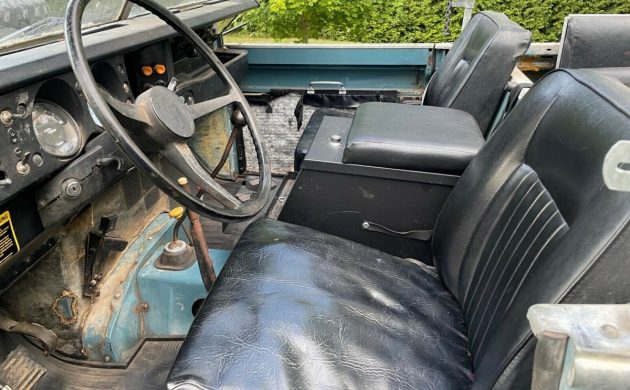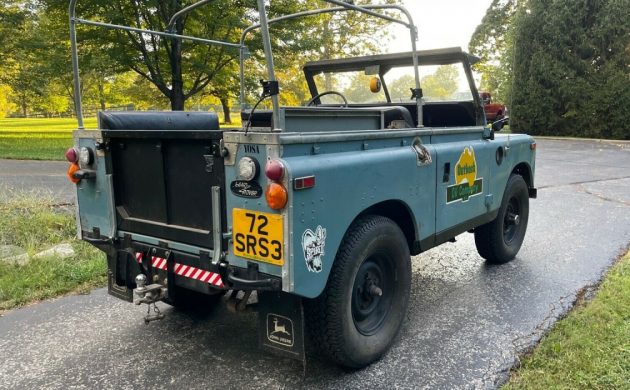It might need an engine, but this 1972 Land Rover Series III in Rogersville, Missouri could provide a second lifetime of service and enjoyment for someone willing to sort out its shortcomings. The seller says it starts and runs but not well, and oil may be getting into the combustion chambers. The listing here on eBay includes numerous excellent pictures and more information. Potential new owners can click Buy It Now for $10,800 or try their luck with the Make Offer option.
Many vintage Land Rovers get the royal treatment, restored to factory perfection, but that destiny could have never been imagined when these sturdy steeds left England to explore remote corners of every inhabited continent. I’ll take mine as original as possible.
The aluminum (or is that aluminium?) body won’t rust per-se and looks largely dent free. This unit comes with a hard top, windows, and a rear door, enough to fully enclose the vehicle for nasty weather. I’ll go out on a limb and guess that the “Outback Oil Company” stickers are from an amusement park. More knowledgeable guesses are welcome in the comments below. The John Deere mud flaps make a subtle reminder that, as much as a tractor is a farm implement, the Land Rover is a “bush implement,” a practical tool, perfectly suited to its intended environment i.e. anywhere that roads are rugged or do not exist.
What must be one of the smallest seven-passenger SUVs made, the SWB (Short Wheel Base) Land Rover Station Wagon offers a handy conversation pit in the rear, perfect for recollecting the highlights of the day’s adventure on the return to camp. The rubber floor mat makes it easy to clean up the remnants of muddy boots and gutted game.
The 2.3L (140 cid) inline four-cylinder gasoline engine makes 70 HP and 120 lb-ft of torque. An I4 diesel and gasoline I6 were also available. Though no PTO (Power Take-Off) options are described or shown on this unit, it’s interesting that the Land Rover could be ordered with multiple hydraulic or mechanical PTO accessories. In fact, the frame comes with holes for the PTO shafts even if the vehicle is not so-equipped. Like a vintage Jeep Wrangler, there will always be buyers and a lively aftermarket for these classic Land Rovers. Would you put this Series III to work off road or pretty it up and put it on a shelf?






Always liked the “Landie”, it’s off roading with a touch of British class, not that these yahoos out here would know anything about that, with their diesel this and lifted that. I’ve seen just about every 4×4 configuration here, but never a Landie. Always felt, we had the CJ and the Brits had their Land Rovers. Hollywood used Landies in every wild animal show and most popular was the hoaky, yet entertaining TV show “Emergency”, where Randolph Mantooth drove one, which I read, was actually his own in real life. Great trucks, mate.
Oh, just one more thing since I’m relogging in anyway, why do these idjits insist on having a dangerous lift jack like that emblazoned on their bumpers like a right of honor? They are made for high profile vehicles, but are unstable on level ground, I can’t imagine them out on a trail. A bottle jack and a block of wood seems safer.
It’s more important to look cool than to use common sense and be safe?
Have you had much experience with a High Lift Jack? They are not made just for high profile vehicles. If you have much experience with them you understand how versatile they can be. That said they do demand a lot of respect as does any tool. I learned many years ago that if you off-road a lot a winch, a High Lift jack, and a shovel are required equipment. I won’t go into the many uses but they are nick named a Handyman Jack for a reason.
That said we have owned two Land Rovers a 64 and a 65 that my dad purchased new at the time. I didn’t drive the 64 but I did drive the 65. Both were extremely underpowered and they have weak axles and springs. Those were the parts that failed several times. The other issue at that time parts were not readily available but I would imagine it is a bit better today.
Land Rovers were pretty spartan at the time as were most utility vehicles, Jeeps, Scouts, and early Broncos. Not to uncomfortable in comparison to similar vehicles of the era. I personally think they are over priced and over hyped but still an interesting vehicle.
If you can’t image a Hi Lift on a trail, then you’ve obviously never been offroad. Hi Lifts are basically a swiss army knife version of a jack. They are made for lifting, pulling, pushing, and more jobs than a bottle jack would ever be able to do.
Landies look cool and the aluminum body is a plus. However early ones have steel frames that rust out so easily, that they are the only vehicle I can think of that actually sells for a premium with a replacement frame! Therefore it is essential that any potential buyer verify the condition of the frame before buying one of these.
frame and bulkhead are steel and can rust. check those carefully
Not to steer off topic but the comment on the high lift jack is right on. Now that that is out of the way, I absolutley love patina Series Land Rovers and almost purchased a couple over the last year. Too much money though by the time they could be made reliable for a trail, so I ended up buying a rust free Ex Forest Service Cherokee with factory skid plates, Ltd Slip, up country suspension, etc. Got my patina and a riliable light trail rig for a fraction of the cost. Still want a Landy though if the right one comes along.
Do some research on the hi lift jack. They can, and do, kill. They are also indispensable for off-roading.
I have been using High Lift Jacks for over 50 years. They are as dangerous as you make them. They demand respect just like any other tool. When you need them they are indispensable. I have seen and heard of folks getting banged up and pinched. Like I said they demand respect. I have used them countless times and managed to come out unscathed. Just keep yourself out of its way.
Set the body on a 3/4 ton Dodge 4×4 chassis with a Cummins and a manual transmission, it would be indestructible.